Hey there and welcome to our BMAT scoring and results guide – all you need to know about this topic.
Up until now, most of your exams have probably been scored as a percent, with the aim of getting 100% (or as close as you can).
The scoring of the BMAT is slightly different, and this guide should help you decipher how this works and how to interpret results.
By doing so, you can pick up some strategic tips about how to approach the exam, and learn how to play to your strengths when considering how the BMAT fits in with your all-important Medicine application to Universities.
By now you know the drill, you can start at the beginning and read all the way through. If you’ve got specific questions you want to be answered, hop straight to them with the Table Of Contents below.
Table Of Contents
- How Do BMAT Scores Work?
- Section 1 & 2 Scoring Explained
- BMAT Section 3 Scoring Explained
- How Is Your BMAT Score Used By Each University?
- BMAT Cut-Off Scores
- Analysis Of Previous Years’ BMAT Scores
- What Difference Do A-Level Subjects Make To Your BMAT Score?
- What Is A Good BMAT Score?
- Getting BMAT Re-Marked
- Conclusion
How do BMAT scores work?
Knowing how the scoring works can help you adapt your exam technique as it differs from exams you are used to. The scoring can be broadly broken down into two parts: Section 1 & 2 and Section 3.
We’ll start by explaining Section 1 & 2.
BMAT Section 1 & 2 Scoring Explained
Each question in these Sections is worth one raw mark (no matter what the “difficulty”!).
Knowing this means you can divide your time roughly equally between questions. Some easy questions will take seconds, but you should make sure you do not spend ages on the harder questions and miss out on easy ones that might be at the end of the test, as they are all worth the same.
Additionally, there is no negative marking (or to side-step around that double negative: a wrong answer is not penalised).
This means you should make sure that by the end of the exam there is an answer for each question. Even if some of these are completely random guesses, there is still a chance it could be right and there is no harm if it is wrong – to quote the old adage “the only wrong answer is no answer”.
Your total raw mark is then correlated to a BMAT score for each Section ranging from 1 (low) to 9 (high).
Here’s where it can start getting a bit tricky to understand; the conversion is not linear, so it ends up that 5.0 is roughly half the raw marks, 6.0 is scored by the best students, 7.0 and higher is only achieved in exceptional cases.
It’s likely that as you start practicing papers and getting marks, you want to see how you fare on this BMAT score.
Below are some ROUGH conversion charts for you to see where your score may fall. We must really emphasise that the conversion changes year upon year, so this will give you a good guideline but may not be prescriptive for every year.
You can see the rough BMAT conversion tables below.
| BMAT Score | 2.3 | 2.8 | 3.2 | 3.6 | 4.0 | 4.4 | 4.7 | 5.0 | 5.4 | 5.7 | 6.0 | 6.3 | 6.7 | 7.2 | 7.8 | 8.4 | 9.0 |
|---|---|---|---|---|---|---|---|---|---|---|---|---|---|---|---|---|---|
| Raw Marks [Section 1] | 4 | 6 | 8 | 10 | 12 | 14 | 16 | 18 | 20 | 22 | 24 | 26 | 28 | 30 | 32 | 34 | 35 |
| BMAT Score | 1.5 | 2.5 | 3.1 | 3.7 | 4.2 | 4.6 | 4.9 | 5.2 | 5.5 | 6.1 | 6.7 | 7.6 | 8.2 | 9.0 |
|---|---|---|---|---|---|---|---|---|---|---|---|---|---|---|
| Raw Marks [Section 2] | 1 | 3 | 5 | 7 | 9 | 11 | 13 | 15 | 17 | 19 | 21 | 23 | 25 | 27 |
What you need to take away from this as that whilst it may be nice to aspire to, full marks are not required to give you even an exceptional score of 7.0+.
Again, this feeds into the whole idea of not spending ages tied to one question, as you do not need to get every single answer correct.
The distribution of scores often looks something like this (this is from 2019, and these results will be discussed in more detail later).
The graph is to really show you what most candidates who sit the test end up getting as many students come into the BMAT with the mind-set that only a near-perfect score is good.
This is clearly not the case as even being in the top decile probably equates to a score of 6 or above.
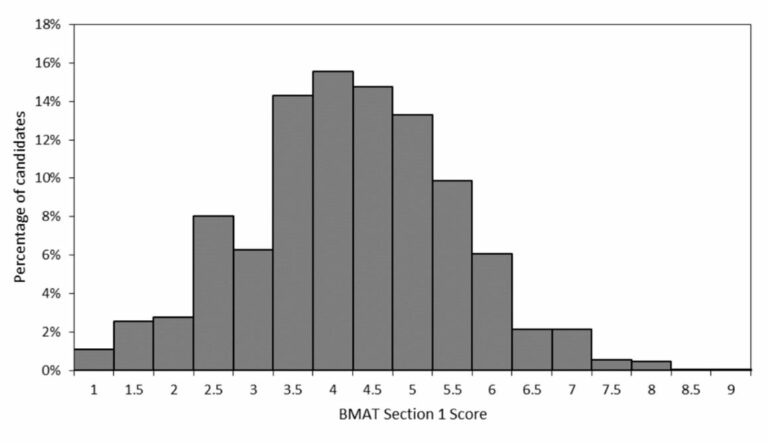
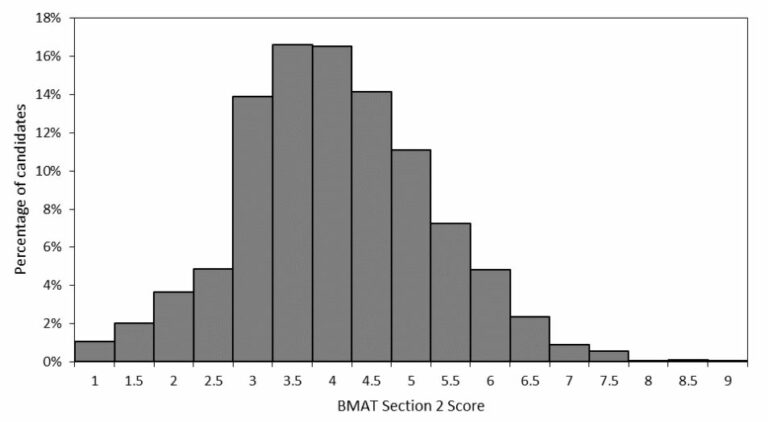
BMAT Section 3 Scoring Explained
There is no score conversion for Section 3. Instead, your Quality Of English is marked on a scale of A (high) to C to E (low), and your Quality Of Content is scored from 0 (low) to 5 (high). Here is the criteria:
| Quality Of English | Quality Of Content | ||
|---|---|---|---|
| Band A | Good use of English – clear, fluent, good use of grammar and vocabulary | Score 1 | The essay has some bearing on the question but does not address it fully |
| Band C | Reasonably clear use of English – reasonably fluent, some errors | Score 2 | Addresses most of the question, but has significant elements of confusion |
| Band E | Rather weak use of English – not easy to follow, faulty grammar | Score 3 | Reasonably well-argued, may have weakness in the argument |
| Score 4 | Good answer with few weaknesses, all aspects of the question are addressed | ||
| Score 5 | Excellent answer with no significant weaknesses | ||
As this can be subjective, two examiners mark this Section (unlike the other two which are machine-marked) and if the two marks are the same, or no more than one mark apart, you get the average.
For letters, averages work like this: AA = A, AC=B, CC=C, CE=D, EE=E.
For example: if one examiner gave you 3C and another gave you 4A, the average would be 3.5B.
If there is a larger discrepancy, the essay gets marked again and the mark is reviewed by a BMAT Assessment Manager.

- A place on the BMAT Crash Course
- Our Awesome BMAT Online Course
- 12 Months access BMAT Ninja
- 300-page BMAT workbook
- 5 x Section 3 Essay Edits
How is your BMAT score used by each university that requires the BMAT?
Now you know how the scoring works, the following table guides you through the ways each University states they use the BMAT score.
You should check this is up-to-date closer to the time with the specific University admissions website in case any changes are made.
In general, they are used to decide who to invite for interview and holistically for who to extend a place to, but some Universities do not officially announce how this is done so getting as good a score as possible is important.
Additionally, some Universities place more of an emphasis on a specific Section’s score (for example, Oxford weigh Section 1 and 2 more) and some only use cut-offs in certain Sections such as Section 3.
If you sit the September exam, you should have a think about where your strengths may lie in terms of these uses of the BMAT, and also make sure you meet any cut-offs to avoid wasting a choice.
| University | How BMAT Score Is Used |
|---|---|
| Cambridge | The BMAT is used holistically alongside the personal statement and grades to decide who to invite to interview, and who should be offered a place. They state that there is no ‘pass’ mark, and those who achieve a higher BMAT are more likely to be interviewed. As they interview 90% of applicants, it probably plays less of a part here, and more in the final decision. For a rough guide, according to a Freedom of Information Act request, in 2019 the average BMAT score of conditional offer holders for Medicine was: Undergraduate - 4.6, 4.9, 3.2 (Section 3 score is turned into a number, perhaps with different weightings) Graduate - 4.4 4.2 3.3 |
| Oxford | BMAT results are used alongside GCSE performance (alongside other factors) to determine short-listing and who to call to interview. For the numerical ranking using the GCSE and BMAT scores, both are evenly weighted. In terms of the weighting within the BMAT, in 2019 the weighting was: Section 1 = 40%, Section 2 = 40%, Section 3 = 20%. In Section 3’s score, the quality of English was given a single weight, and quality of content was given double the weight. This means, there is no cut-off and how well you need to do depends on how well all other applicants do, and how strong your GCSE score is. |
| Imperial | A cut-off score is calculated using the ranked candidate BMAT scores vs number of interview sessions. This means the cut-off changes each year, but previous years may be used as guide. For a rough guide, for 2019 entry the minimum scores were: 4.1, 4.2 and 2.5C. |
| UCL | There is no cut-off as BMAT scores are used alongside the UCAS application. High scores in each Section will strengthen an application. Candidates with scores that are below the average for their cohort are less likely to be successful. For a rough guide, the average BMAT scores for applicants in the 2019/20 cycle were: 4.3, 4.1, 2.9A. Note: as of 2020, they no longer discuss Section 3 at interview. |
| Leeds | There is no cut-off, and the BMAT is used at “stage 1” of the selection process to decide who gets invited to interview. Note: the essay Section will be used for a discussion at one of the MMI stations. |
| Brighton & Sussex | They score the BMAT out of 28, with 9 marks for each of Section 1 and 2, and 5 marks for each element of Section 3. All applicants are then ranked according to their score and invited to interview according to how many spaces. Additionally, there is a cut-off for ALL the Sections (ie you must fulfil ALL of these requirements) unless there are extenuating circumstances. • Section 1: a score of at least 3 or higher • Section 2: a score of at least 3 or higher • Section 3: a score of at least 2.5 C or higher As a rough guide, for 2019 entry 16.1 or higher was needed to get an interview. |
| Lancaster | There are various sources on the internet, but according to the official statement from the University, the BMAT is used as part of stage two alongside the personal statement and academic reference to decide who is invited to interview. This means there is no cut-off and a good BMAT score is dependent on the rest of the applicants and other elements of your application. |
| Keele (overseas fees students only) | For 2018, the BMAT cut-off was based on the scores of the candidates applying. Applicants are ranked before the interview as long as they fulfil the academic requirements for admission. They do not publish previous years’ cut-offs. |
BMAT Cut-Off
As you can see from the table above, BMAT cut-off scores are used by some unis.
This can vary from year to year, just as the test and the cohort of applicants vary each year.
You can generally use the previous few years as a guide but be mindful that they do indeed move around a bit (although it is very unlikely that there will be a dramatic change).
The type of cut-off that should really influence your choice is one that is published beforehand as in the case of Brighton and Sussex.
If you have your results before applying and do not meet this cut-off (without extenuating circumstances) you should not waste an application.
Importantly, not all Universities use a cut-off and remember that there is a big difference between an average score and a cut-off.
By virtue of an average for successful applicants, a fair few will have scored below the average, so remember the holistic nature of the process and do not be scared to use a choice if you are hovering slightly below an average, but have a strong application.

Analysis of previous years’ BMAT scores
In this section, we’ll go into a little more detail about the results of past BMAT scores.
SECTION 1
Looking at the table below (drag the image to show the previous/next years’ BMAT scores), you can see there are some changes year-on-year but the broad shape stays the same.
You can see that the median usually sits around 4.5 which is expected as the test is designed to allow the average candidate to get 4-5.
With regards to 2019, the median was slightly lower than 2018 and there is a significant drop-off of students scoring less than 3.5, which suggests the 2019 Section 1 paper was a bit easier.
Looking at the very small percentage of people who score above 6 (approximately: 6% in 2019, 6.5% in 2018 and 15% in 2017) shows how hard the Section 1 paper is in general, and how it should not be underestimated and neglected in practice.
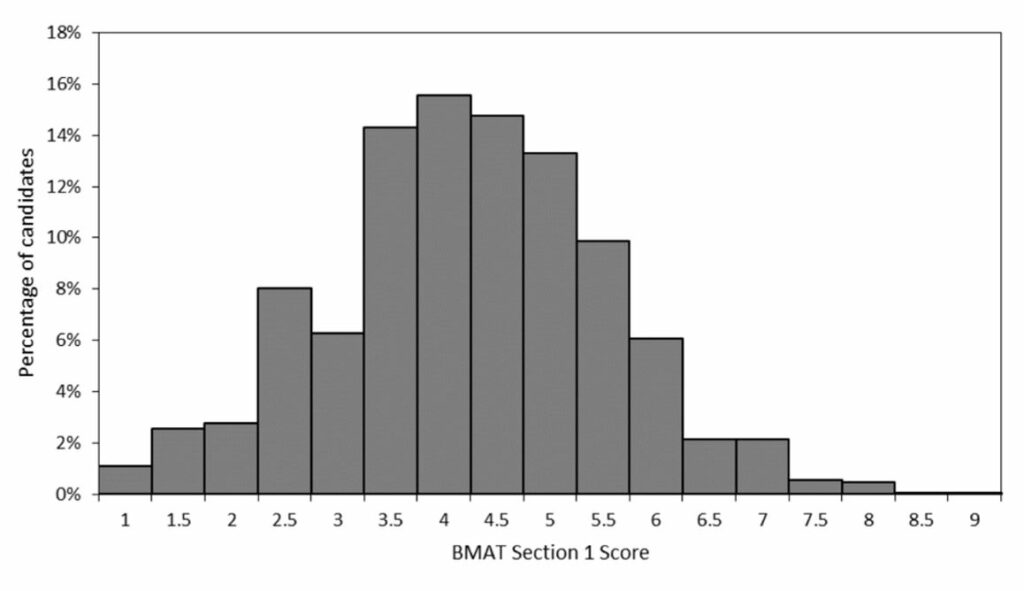
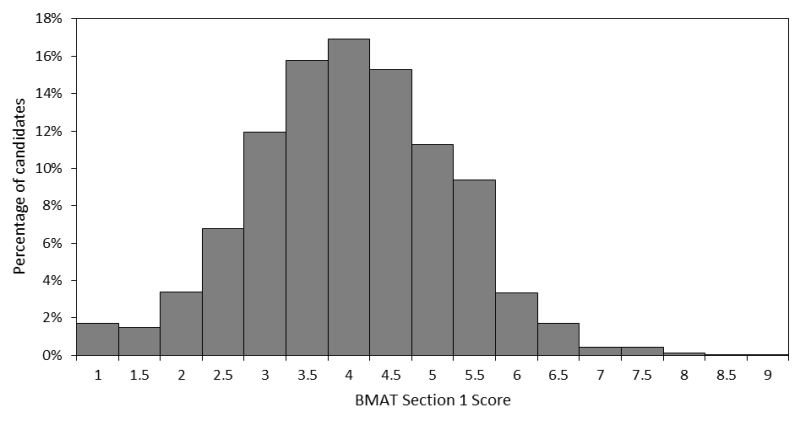
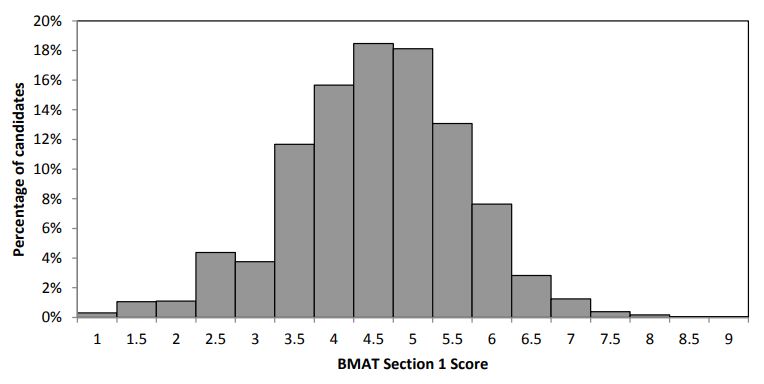
SECTION 2
2018 seemed to be an odd year, and the parabolic shape for 2019 looks more like 2017. Looking at candidates who scored 4-5 (approximately: 41% in 2019, 34% in 2018, 38% in 2017) shows again that this is the average sort of score of a candidate sitting Section 2.
Looking at candidates who managed to score 6.0 and above (very approximately: 10% in 2019, 13% in 2018 and 16% in 2017) again shows the difficulty of this Section, and suggests that in 2019 it may have been harder to score exceptionally high scores than in previous years, and there is more of a gathering in average marks.
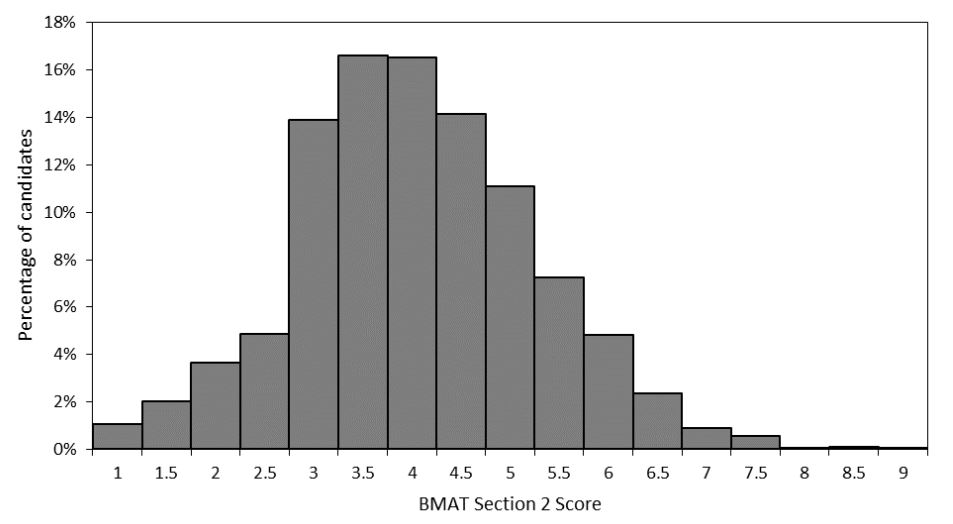
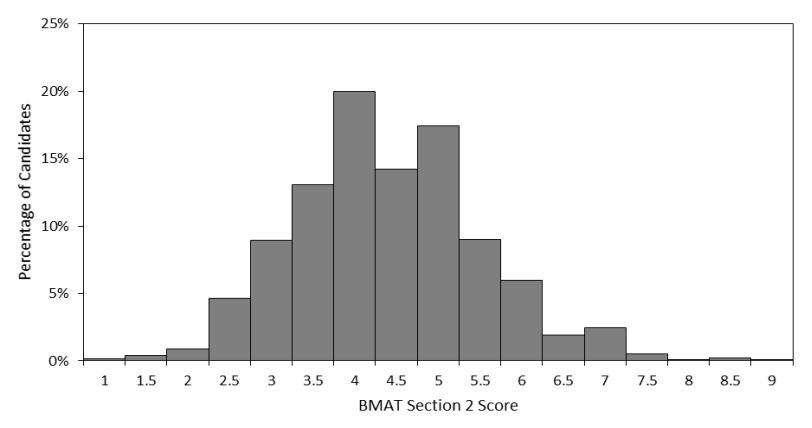
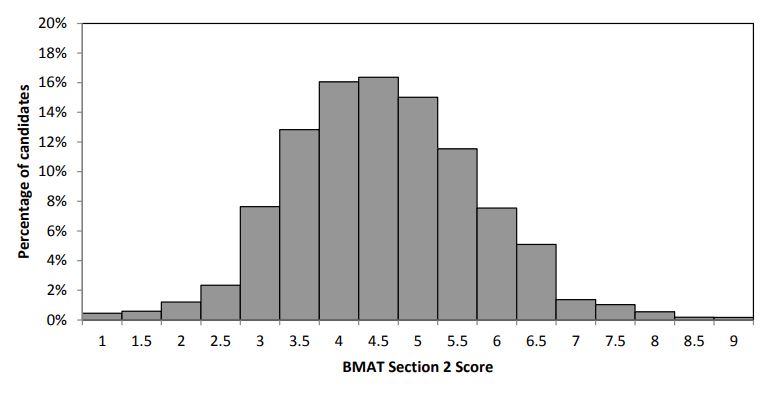
SECTION 3
There are some clear trends when looking at the spread of scores.
The vast majority achieve an A in their quality of English, which shows how attainable it is and how you should be able to realistically achieve this.
The quality of content scores show that whilst it is unlikely you will get a 5, it is also hard to get a low score. By far, the most common score across the years is 3A.
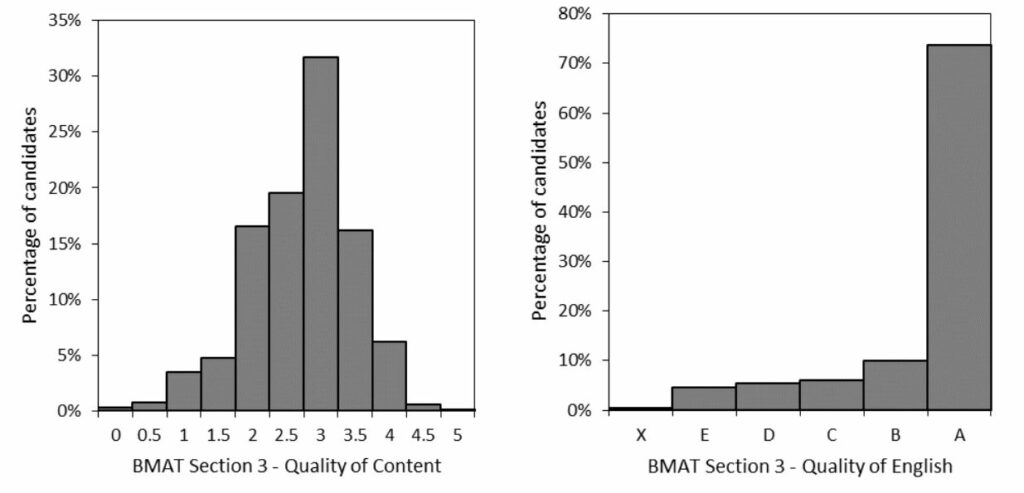
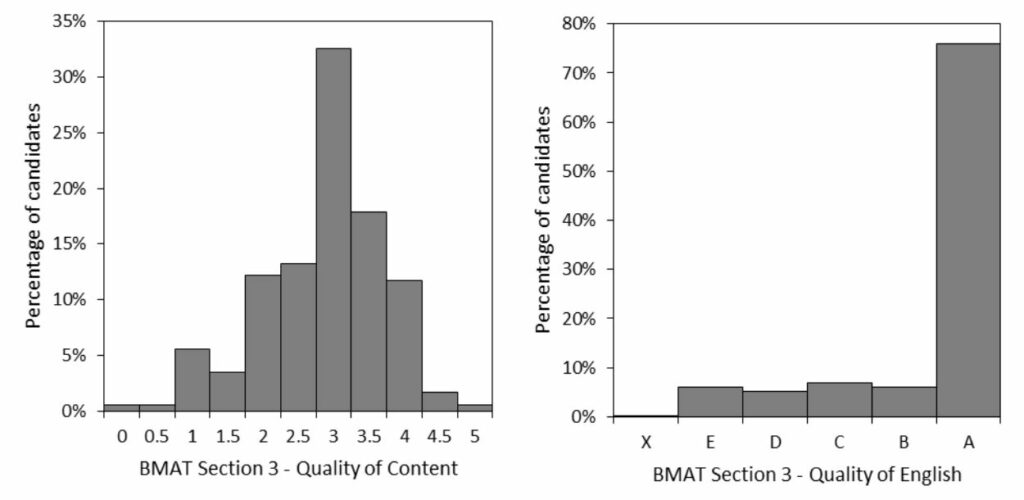
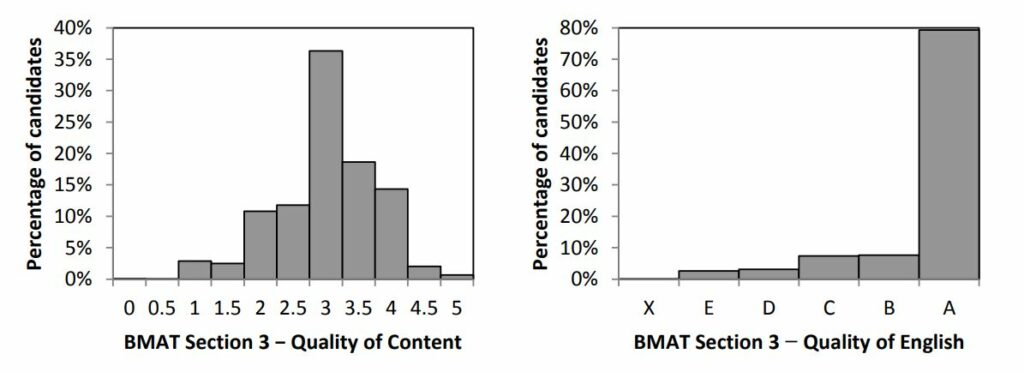
What Difference Do A-Level Subjects Make To Your BMAT Score?
The logic behind looking at this is that some students feel that they may be disadvantaged in Section 2 if they have not taken certain subjects at A-level (ie. Maths, Further Maths, Biology, Chemistry and Physics).
There is a pending request for 2019 results, but in terms of 2018 results, Cambridge has released a set of statistics they compiled.
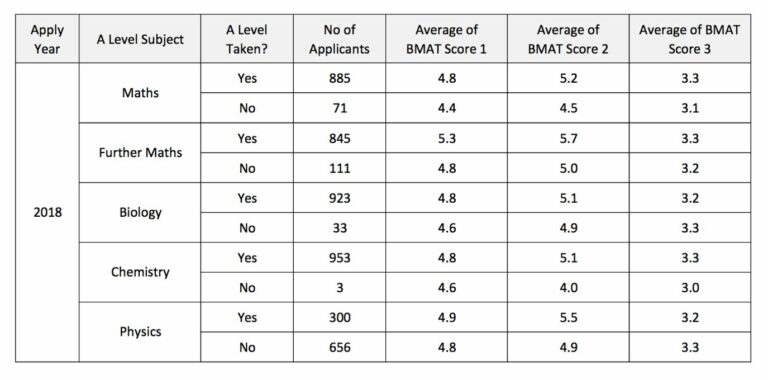
Looking at these statistics, perhaps not studying Maths or Chemistry could result in a lower score (or even Physics to a lesser extent).
However, it should certainly not be enough to put you off taking the BMAT if you do not take one of these subjects.
Every year huge numbers of applicants get in who do not take this combination (including myself!).
Additionally, these are results from Cambridge ONLY, and do not represent national averages or those from other unis, or even those from 2019 which could be different.
What it should do is inspire you to brush up on subjects you have dropped and give them a bit more care and attention when it comes to your preparation.

- A place on the BMAT Crash Course
- Our Awesome BMAT Online Course
- 12 Months access BMAT Ninja
- 300-page BMAT workbook
- 5 x Section 3 Essay Edits
What is a good BMAT score? Is it good enough to get into X?
We’ve come to the most commonly asked question, but unfortunately the answer is not simple.
As the above information shows you, this changes year upon year, and so there is no set value above which is ‘good’.
Simply being above a cut-off score doesn’t guarantee a result is good and being below for one cut-off doesn’t mean your score is necessarily bad for other unis as they also depend on the specific cohort of applicants in that year for that medical school.
It is important to remember that the BMAT is important, but it is only one element of a range of factors considered such as interview performance, academic ability and your personal statement, that will feed into the final decision.
Look at previous years for rough guidance, but take everything with a pinch of salt as it is unlikely that the BMAT will be the make-or-break aspect of an application over other areas such as your interview.
Remarking of BMAT score if you feel you’ve been judged unfairly
Most people cannot accurately tell how well or badly they did in such an exam but if you end up opening your results and feeling very shocked, there is a process you can go through to get a remark.
You must submit the result enquiry form found on the link below (or if you sit the exam in November, your centre must submit it on your behalf).
You have to pay a fee of about £34 but if your result changes, there is no charge.
The remark should arrive within 5 working days, so it should not delay your application. A word of caution, your result can go up or down from this process, so only pursue it if you reasonably believe there has been an error.
The End Of The Road (For This Article)
That essentially sums up the scoring and results of the BMAT.
The key things to remember are the techniques you can implement to maximise scores (eg don’t spend too much time on one question as they are all worth the same marks).
Additionally, remember that each University will use the BMAT differently, so consider playing to your strengths when making applications, especially if you have your results prior to submitting your choices.
Good luck with the test and application process as a whole!
If you’re looking to get some support with the BMAT, 6med are here to help. Check out the BMAT Bundle (if money is an issue, we offer a very generous bursary scheme here) – it’s all you need to nail the exam and get your medical school place.

- A place on the BMAT Crash Course
- Our Awesome BMAT Online Course
- 12 Months access BMAT Ninja (Used by 1 in 2 applicants)
- 300-page BMAT workbook
- 5 x Section 3 Essay Edits